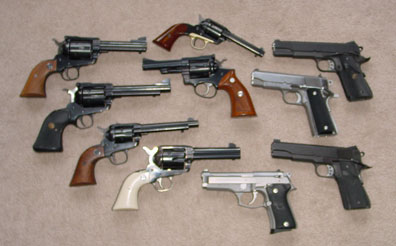
*Utility Handguns*

A utility tool, in my mind, is one which can be called upon to do many things. It should do some things acceptably well in the absence of other more appropriate tools, some things very well and some where no other tool would or could do better. When hiking in the woods I always carry a firearm of some sort. I consider it important to carry a pistol whether or not I have a rifle or shotgun with me. It just seems like insurance. Most of us think of a nice Sig or Colt 1911 or even a Glock when we think of a survival or utility pistol, but I feel that they are more suited to defense against men rather than animals that may require more powerful arms. There are those here that would not go into the woods without a sidearm on their belt, even if they carry a rifle when in the woods, and I am one of them. You will find times when you must put the rifle down to do something like carry firewood, fishing or gutting a fresh kill. Bears and other predators have been observed being drawn to gunshots, perhaps looking for a gut pile or other tidbit. Like most I donít want to carry any more weight than I have to, but I still elect to carry a pistol, usually a single action revolver in .45 Long Colt (LC) or .44Mag along with at least 20 extra rounds on my belt.
Just two examples where actual use of a handgun to defend ones life and limb against animals can be found in newspaper archives here in Alaska. A couple years ago two men were carrying a litter with a moose quarter up a trail toward their pickup, when a grizzly bear charged from their front. Startled the front man on the litter slipped and fell backward, the one at the rear drew and fired his .45 LC single action revolver, the shot hit the bear in the head killing it instantly. The bearís nose ended up just three feet from the man who had fallen. Another instance just last year was where a group of three men were fishing along a local salmon river at night (not uncommon). A young sow with a cub charged the first man. Startled he threw a 12ga shotgun at the bear and then dove into the river to get away. The second man, hearing the splash turned to see the bear charging from a few feet away. He drew a 9mm auto from a shoulder holster and began shooting. His first shot broke the front shoulder and caused the bear to veer off and stumble. The third person got into the act and both emptied their pistols into the bear, killing it. This last example is interesting in that a 9mm pistol was used. Most people here were surprised that such a puny round would do more than enrage the bear. The fisherman used 124gr FMJ and his first unaimed shot luckily broke one of the front shoulders, the FMJ bullets penetrated deeply providing the key to killing the bear and surviving this event. In both instances the people involved were fortunate.
In a separate incident from recent history is a story about a young couple staying in a cabin. They were startled by a particularly brazen black bear that chased them from the cabin. All they had was a .22lr pistol. After climbing to the roof it was decided that the husband would jump down with the .22 when the bear was occupied on the far side of the cabin and run to the lake, paddle across to the neighbor to get a bigger gun. The wife stayed on the roof where they thought she would be safe. When the man returned with the neighbor they killed the bear over the remains of the young wife.
Over the years I have carried shotguns, rifles, semi-auto pistols, double action revolvers and single action revolvers. I have carried under my coat, in shoulder holsters, in belt holsters, in my hands and on a sling over the shoulder. I have played with different cartridges from .22lr to .50AE in pistols and up to .338Win Mag and .45-70 in Rifles all with an eye to what to use for hunting, fishing, camping, hiking or for defense. What works for me may not be the best for you.
Lets talk about some of the things that I consider important. First is to have it with you when you need it. It has been said many times before but it bears repeating: the most wonderful firearm in the best caliber will do no good what ever if it is in the closet when you are in the woods or leaned up against a tree 20 feet away. You must carry a suitable weapon with you.
Next it must be utterly reliable and of suitable power. Autos are great urban survival tools, but when we start trekking into the back woods where assistance or repair parts are impossible they may not be the best (above lucky example noted as an exception). I have found revolvers, especially single action revolvers, would provide a better UTILITY tool in the backwoods where they may not do as well in an urban or city environment. Exactly what do I mean by utility? Well for starters I want a robust handgun that is very reliable and able to perform many tasks for a woodsman and survivor. I want it chambered in a reliable, powerful and easily found cartridge. It needs to be easily cleaned and maintained. And finally it needs to be accurate and easily shot. My sonís .50AE Desert Eagle is not what I consider an easily holstered nor carried pistol. By the same token my small and easily carried .38spl Taurus M85 just doesnít have the accuracy to take the heads off of grouse at even 20 feet. I have finally settled on revolvers, specifically single action revolvers. They can be found chambered in very powerful cartridges like .44mag .45LC and .454Casull. I say most because there are many single actions out there that were designed for black powder that are still around and functional, but I would not use one of them with modern ammunition.
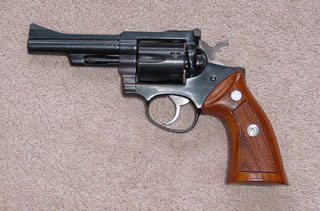
Even though I really like the single action revolvers I have found Double Action Revolvers useful if you learn how to shoot them Double Action (DA). In the mid Ď70s I read "No Second Place Winner" by Bill Jordan and decided that I would check out double action revolvers. Up to that point I shot 1911A1s or a Ruger Blackhawk in .357 almost exclusively. Specifically due to what I had read in Jordan's book, I bought a Ruger Security Six in .357Mag and spent a lot of time learning how to shoot it in double action by shooting PPC (Practical Police Course). For those of you that may not know, PPC emphasizes the use of double action revolver shooting (or at least it used to, I haven't kept up). It really helps a person to learn to accurately shoot a DA pistol quickly. That pistol proved to be very dependable and resilient. I shot unknown thousands of .38 specials and in excess of 5,000 (five thousand) full power magnums, in fact the magnum loads were mostly reloads that were in excess of factory pressure and velocity. I shot it for almost 20 years before it needed to be sent into the factory to replace a bent cylinder release, they returned it repaired and reblued free of charge. I have a lot of trust in that gun, it shoots well and just fits (mostly due to the practice). More recently I purchased a particularly beautiful Smith & Wesson M29 Classic .44Mag that I thought was just the ticket for roaming the woods. They have an excellent reputation and were specifically built to eliminate many of the problems that were identified in the previous Model 29s, but my example had to be returned to the factory after only a few boxes of full power magnum loads because the timing was so far off it would not hit the primer on at least one chamber when shot double action. In single action it would sometimes not lockup properly. Of course the factory repaired it and returned it free of charge, but I did not have much trust in this gun after requiring maintenance after only a few boxes. After all I feel that a weapon should last for a reasonable length of time and use, why should we have to return a firearm to the factory or another well trained armorer after only a few rounds if you are supposed to live or die with it. Not to mention when we are surviving with one we will not have the option to send it in for warranty repair. I sold it soon after getting it back from the factory because I didn't trust it anymore. I owned a Ruger Redhawk in .44Mag for a few years and sold it to a friend (when I needed the money), he shot it for over eight years and sold it still in working condition to someone else. The Redhawk went through a lot of ammunition without difficulty and I felt well armed with it. Many of my accessories that I had purchased for the Redhawk also worked in the M29 (specifically speedloaders and holsters)
Double actions in good pistols that can handle sufficiently powerful loads would prove to be useful in the woods, providing you spend the time to learn how to shoot it in double-action accurately and under pressure! You can shoot a DA pistol in SA but they are much faster in DA. Besides why pay the additional price for a feature you don't use. Ruger double action revolvers have worked well for me.
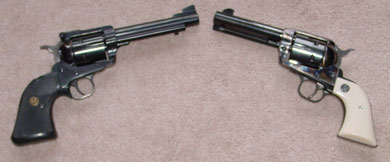
In my area of the woods you will still find single actions in most of the hunters, fishermen, woodsmen and hiker holsters. Some of the reasons are price, versatility and power as well as their simplicity and reliability. With some practice and advice from more experienced shooters you can shoot a single action just about as fast as a double action, especially when shooting the larger magnum cartridges. The only real downside to a single action is in reloading the cylinder, one chamber at a time rather than being able to use a speed loader. One of their benefits is that like all revolvers they will shoot anything you can stuff into their chambers. If you get to the point that you are scrounging powder and lead they will still work, they are not picky as far as ammo is concerned. They can be very reliable over the long term especially when coil spring models are used. The New Model Ruger Blackhawk series can be loaded with 6 (six) rounds safely with the hammer down. Old Models (prior to 1973) and Colt style pistols should only be loaded with 5 rounds with the hammer down on the empty chamber. Even though many of the old Colt style pistols that use leaf springs (the more fragile type of spring) produced around 1900 still work just as designed from the factory, I still prefer the coil spring revolvers.
There is a proliferation of single actions produced by a number of companies with the resurgence of Cowboy shooting matches. Colt and numerous other companies are producing the Peacemaker and clones in every conceivable configuration, some are built better than others. However, I donít like the Colt design for long term use due to their use of leaf springs, which have proven more fragile (in my experience) over the years. These springs are easy to replace, but again if I am in the woods and a spring breaks it will make a better hammer until I can get it fixed. And if I am relying on that firearm for survival, my survival would be less sure.
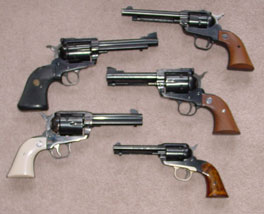
Ruger single action revolvers are my favorites, they use coil springs and are very reliable. I have owned models in .22LR, .357Mag/.38Spl, .44Mag/.44Spl, and .45ACP/.45 LC. I personally like the convertible models with a spare cylinder that will fit an additional cartridge, like the .22LR pistols with a spare cylinder in .22WMR. These seem particularly versatile in that they can shoot just about any .22 rimfire ammo found. I also like the .357Mag/.38spl model with a spare cylinder in 9mm or the .45ACP/.45LC model. When scrounging ammo these models can shoot a lot of different loads. I have found many used at gun shows or gun shops for as little as $200. They are easy to clean and disassemble. I prefer the shorter barrel models not longer than 6 inches. I have a 4 5/8inch .22LR/WMR, a 4 5/8 inch .45ACP/.45 LC and a 5 Ĺ inch .44 Mag that I carry often when in the woods .
Which caliber to use is an often asked question. There are numerous arguments for .357Mag or .41mag or 44mag or .45 Colt. I am not going to try to say what is best for what. Two things that would dictate this are first your skill with any given cartridge and second the type of varmint you need to defend against. In most areas the .357Mag or .41Mag would probably do well, you might even make a case for the 10mm Auto in most of the lower 48. If I were in big bear country I would opt for the largest cartridge I could carry comfortably and then practice until I felt very confident with that load. Here in Alaska I carry either a .45 Colt or a .44 Mag loaded with heavy bullets at high velocity. The load that I practice with is the same as the load I hunt with and carry, either a 250gr Sierra Silhouette bullet in my .44Mag or a 255gr hard cast lead Keith style in my .45Colt. Both are very accurate and provide deep penetration, which is what I want. I have taken heads off of grouse out to 35-40 feet with them and would not hesitate using either on big game (yes even a moose out to 50 yards or so). No matter what I am hunting I try to get in as close as possible before taking the shot.
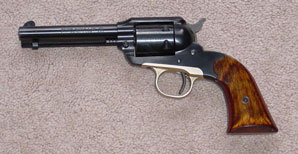
Kit guns by definition are small accurate guns easily carried in your kit (a term used by older woodsmen to describe their equipment that they take with them for a hunt or extended stay in the woods). Kit guns are usually small J frame size chambered in .22lr. I had a small model 63 Smith & Wesson for a few years that was very handy. I canít remember why I traded it off or for what now. I also like the Ruger Bearcat model for these duties, because of light weight and accuracy out to 25 - 30 feet. I have used my .44mag and .45LC to take the heads off of grouse while on hunting trips, though I will admit that a .22lr would have been better and a lot quieter. Using a .22lr I can kill most small animals but I am not going to try to kill large game nor try to kill a bear with it, unless of course that is all I got and the bearís breath is really bad. If I did not have the bears I would consider carrying these smaller guns just for taking "camp meat".
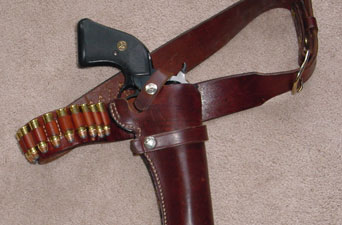
Good holsters are a must. I like leather for my holsters and belts, but I must admit it is for aesthetics rather than practicality. A belt and holster setup should fit both you and the gun. If it is uncomfortable you will not wear it all the time. If it does not fit the gun well it could allow your gun to fall out while you are running or climbing. The gun should fit firmly yet allow easy access and a fairly quick draw. This is something that you must practice before you need it. I am not talking about a "fast-draw artist" who would fan the hammer but a reasonably fast response at getting the pistol out of the holster and pointed/fired at the threat. By the way I do not consider "Fanning" a useful way to fire a single action pistol. You have seen it in the old cowboy movies and some "fast-draw artists" do it, but it is very hard on a gun. I remember watching a fast draw demonstration where the gentleman drew his pistol with his right hand, as soon as the pistol cleared leather he swept his left hand over the top of the revolver and slammed the hammer back with his palm and just kept going, the hammer slipped from his hand and fell to fire the gun. Man he was FAST! I noticed he had taped the trigger down, I guessed so it would not get in the way. When asked why he said he breaks more triggers by not having it back far enough when the hammer falls. This is not a good practice, not to mention your aim is disturbed by the off hand sliding over the top of the gun and hitting the hammer spur. Fanning the hammer is not something that a smart man would do, maybe good for the movies but not in practice.
Finally, I would think it not necessary to say but, practice with the rig you will use to carry. I consider this just as critical as actually shooting. You must get comfortable with the holster and method of carry. If it is carried under a coat, practice drawing from under a coat and placing your first shot onto a picnic plate at 30 feet. Practice slowly at first then increase your speed, concentrating on perfect practice not speed. After you practice a while and feel confident, perform the draw and fire a cylinder full into the same picnic plate at 30 feet. Again not real fast, just as fast as you can to perfectly place all shots in the plate. Work at this until you can increase your pace while keeping all shots in the plate. When you feel confident use a smaller plate and move it out to 40 feet. Some ranges donít like you to draw from holsters while on the line so find a place that will let you do so. It is important to do both the draw and fire while attired as you would be in the woods using the holster you plan on using. Remember practice perfection, be perfect in your practice speed will come with more practice.
I cannot emphasize enough the importance of practice and familiarity with a given weapon along with having it with you when you need it. When you need it, you will want to have it with you, just like that commercial "Donít leave home without it!".
All materials at this site not otherwise credited are Copyright © 1996 - 2003 Trip Williams. All rights reserved. May be reproduced for personal use only. Use of any material contained herein is subject to stated terms or written permission.